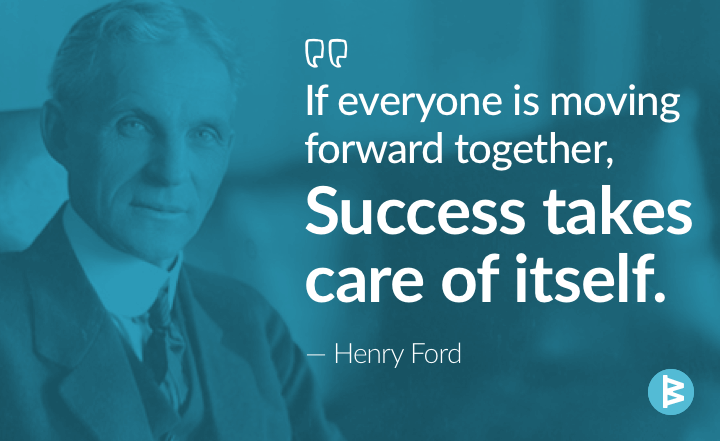
Originally posted on https://www.workboard.com/blog/goal-alignment.php
Two days before Yolanda’s performance review, she sent a 26-page PowerPoint deck intended to summarize her accomplishments for the year. She’d clearly spent hours on the deck, perhaps more than a day packaging and positioning accomplishments. She’d even asked four colleagues to write emails lobbying for her promotion. Although she’d only been on my marketing and strategy team for 18 months, Yolanda had been in the same role at the same level for more than 5 years.
In her mind, this was her year to get ranked at the top of the team and get promoted — the performance model at the company. The 26 pages of presentation and emails were intended to seal the deal.
The goal to get promoted had become the one and only goal.
Her promotion goals eclipsed Yolanda’s efforts to achieve her group’s goals or add value to the organization. Her focus became skewed to getting her contributions “on the record” rather than making great contributions — often consuming team time and draining rather than adding value in the process.
Inevitably, she did not rank among the highest performers on the team. She’d forgotten that career rewards come as a result of value creation and goal achievement, not time in job, positioning and lobbying.
Achievement is The Fastest Path to Advancement
While I respected Yolanda’s desire to advance her career, she would have been better off investing her energy in four key disciplines rather than on self promotion and her outcome at the expense of the organization’s:
1. Align goals up, break them down to actions.
Make sure you understand the strategic and economic objectives of the organization and the specific objectives and key results (OKRs) for your team. Work with your manager to set ambitious, measurable OKRs that align upward and have real impact; break them down into actionable elements and defined tactics for each quarter and month.
2. Know your progress against objectives.
Time flies, as the saying goes. Work the list of actions that achieve the defined OKRs and do a weekly check point on your progress. You own your achievements; don’t rely on others to ensure you get there.
3. Focus on value creation.
Have an unwavering focus on creating value for customers and the organization above all else. Work with this as your genuine purpose every day. Take a minute to assess your commitment to value creation and whether it calibrates with the career success you’d like.
4. Let results do the talking.
Deliver what you committed and then some. If you achieve and exceed measurable OKRs consistently, you create real value for the organization. Results like that speak for themselves and for you.
Alignment and Accountability Are The Leader’s Job
As Yolanda’s manager, I fell short too. Like many managers according to Harvard Business Review, I avoided hard accountability discussions. I could have helped her be more successful for our team and in her career aspirations over the course of the year by being more consistent in four key areas of management:
1. Keep OKRs and priorities visible.
To make it easier for Yolanda and others to stay aligned with the team’s goals, I should have kept specific, measurable OKRs and status of their achievement more consistently visible to the team. Beginning and end of quarter aren’t sufficient in organizations with tens of thousands of people and millions of emails.
2. Track actions and have clear ownership for each deliverable.
To avoid confusion about responsibilities and ensure OKR achievement, I should have over communicated expectations and ownership of deliverables. The clarity on actions reinforces what to focus on and provides an accomplishment roster at year end.
3. Use regular status reports to assess progress and create feedback opportunities.
By getting a regular status update on the specific actions and deliverables required to achieve OKRs, both Yolanda and I would have the same fact base on her results and impact. This creates a specific trigger to note great progress, identify performance gaps on deliverables for goal achievement and establishes strong follow through in the 50 weeks between goal setting and performance review.
4. Give more continuous feedback.
By providing more regular and specific feedback on work product, I could have reduce the gap between Yolanda’s perception and her actual execution. It’s natural to want to avoid difficult conversations but performance conversations just get more difficult with time. Feedback tied to the work product and actions needed to achieve defined goals is essential throughout the year.
These are fairly obvious best practices but difficult to sustain in complex organizations, particularly with the global teams and travel complexities I had at the time. It is incredibly time consuming to compile and communicate the performance fact base and my days were already three time zones long. Email archiving and fractured productivity tools made matters worse by breaking the business narrative into a thousand tiny pieces (lists of deliverables in Excel, dashboards in PowerPoint, endless document revisions in SharePoint and the discussion of status and quality in email and email archives). Without transparency and management efficiency, accountability is hard to achieve on a distributed team.
Recalibrate Now for this Quarter
The human and business cost of goal and expectation gaps are high. Commit to transparency, accountability and achievement as fundamentals in your management model and sustain them in practice. Recalibrate with team members to make sure goals are well understood, close gaps in execution or expectations, and give course-correcting or rewarding feedback where needed. Your performance and your team’s will go up — you and your Yolanda will be happier!
What are your lessons learned on execution and expectation gaps? Do my mis-steps as a manager sound familiar?